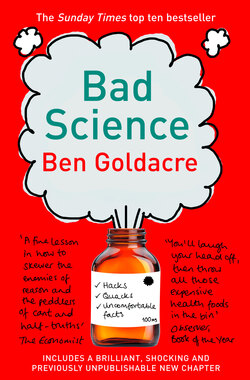Читать книгу Bad Science - Ben Goldacre - Страница 20
Blinding
ОглавлениеOne important feature of a good trial is that neither the experimenters nor the patients know if they got the homeopathy sugar pill or the simple placebo sugar pill, because we want to be sure that any difference we measure is the result of the difference between the pills, and not of people’s expectations or biases. If the researchers knew which of their beloved patients were having the real and which the placebo pills, they might give the game away—or it might change their assessment of the patient—consciously or unconsciously.
Let’s say I’m doing a study on a medical pill designed to reduce high blood pressure. I know which of my patients are having the expensive new blood pressure pill, and which are having the placebo. One of the people on the swanky new blood pressure pills comes in and has a blood pressure reading that is way off the scale, much higher than I would have expected, especially since they’re on this expensive new drug. So I recheck their blood pressure, ‘just to make sure I didn’t make a mistake’. The next result is more normal, so I write that one down, and ignore the high one.
Blood pressure readings are an inexact technique, like ECG interpretation, X-ray interpretation, pain scores, and many other measurements that are routinely used in clinical trials. I go for lunch, entirely unaware that I am calmly and quietly polluting the data, destroying the study, producing inaccurate evidence, and therefore, ultimately, killing people (because our greatest mistake would be to forget that data is used for serious decisions in the very real world, and bad information causes suffering and death).
There are several good examples from recent medical history where a failure to ensure adequate ‘blinding’, as it is called, has resulted in the entire medical profession being mistaken about which was the better treatment. We had no way of knowing whether keyhole surgery was better than open surgery, for example, until a group of surgeons from Sheffield came along and did a very theatrical trial, in which bandages and decorative fake blood squirts were used, to make sure that nobody could tell which type of operation anyone had received.
Some of the biggest figures in evidence-based medicine got together and did a review of blinding in all kinds of trials of medical drugs, and found that trials with inadequate blinding exaggerated the benefits of the treatments being studied by 17 per cent. Blinding is not some obscure piece of nitpicking, idiosyncratic to pedants like me, used to attack alternative therapies.
Closer to home for homeopathy, a review of trials of acupuncture for back pain showed that the studies which were properly blinded showed a tiny benefit for acupuncture, which was not ‘statistically significant’ (we’ll come back to what that means later). Meanwhile, the trials which were not blinded—the ones where the patients knew whether they were in the treatment group or not—showed a massive, statistically significant benefit for acupuncture. (The placebo control for acupuncture, in case you’re wondering, is sham acupuncture, with fake needles, or needles in the ‘wrong’ places, although an amusing complication is that sometimes one school of acupuncturists will claim that another school’s sham needle locations are actually their genuine ones.)
So, as we can see, blinding is important, and not every trial is necessarily any good. You can’t just say, ‘Here’s a trial that shows this treatment works,’ because there are good trials, or ‘fair tests’, and there are bad trials. When doctors and scientists say that a study was methodologically flawed and unreliable, it’s not because they’re being mean, or trying to maintain the ‘hegemony’, or to keep the backhanders coming from the pharmaceutical industry: it’s because the study was poorly performed—it costs nothing to blind properly—and simply wasn’t a fair test.
